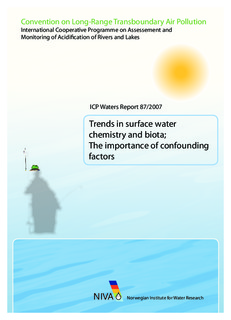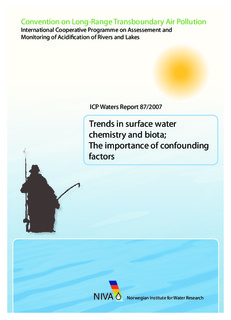| dc.contributor.author | Skjelkvåle, B.L. | nb_NO |
| dc.contributor.author | de Wit, H. | nb_NO |
| dc.contributor.other | Skjelkvåle, B.L. - Project manager | nb_NO |
| dc.date.accessioned | 2014-08-01T10:51:07Z | |
| dc.date.available | 2014-08-01T10:51:07Z | |
| dc.date.issued | 2007-03 | nb_NO |
| dc.identifier | 5385 | nb_NO |
| dc.identifier.isbn | 978-82-577-5120-3 | nb_NO |
| dc.identifier.issn | 1894-7948 | nb_NO |
| dc.identifier.uri | http://hdl.handle.net/11250/213562 | |
| dc.description | Årsliste 2007 | nb_NO |
| dc.description.abstract | The main aim of the ICP Waters Programme is to assess, on a regional basis, the degree and geographical extent of the impact of atmospheric pollution, in particular acidification, on surface waters. Twenty-two countries in Europe and North America participate in the programme on a regular basis. This report contains surface water chemistry trend analyses for ICP Waters sites for the period 1994-2004, including nitrate and dissolved organic carbon, and an assessment of biological recovery. Additionally, effects of environmental factors other than acid deposition – so-called “confounding factors” - on chemical and biological recovery of surface waters are evaluated. Most regions in Europa and North America show significant decreases in sulphate whereas nitrate trends are more scattered. Indicators of chemical recovery – alkalinity, pH and ANC – show improvements, most clearly in Europe. Increases in organic acidity and seasalt deposition delay recovery in some regions. Climate change both delays and enhances chemical recovery depending on region and variable. International cooperative work to abate acidification has so far been very successful, but water chemistry and biology of many acidified systems is still far from any pre-industrial reference condition. Monitoring of future development of water chemistry and aquatic biota in acidified water bodies must continue in order to assess effects of further emission reductions of S and N and confounding effects of climate. | nb_NO |
| dc.description.sponsorship | Statens Forurensningstilsyn | nb_NO |
| dc.description.sponsorship | United Nations Economic Commission for Europe | |
| dc.publisher | Norsk institutt for vannforskning | nb_NO |
| dc.relation.ispartofseries | NIVA-rapport;5385 | nb_NO |
| dc.relation.ispartofseries | ICP Waters report;87/2007 | nb_NO |
| dc.rights | Navngivelse-IkkeKommersiell-DelPåSammeVilkår 3.0 Norge | nb_NO |
| dc.rights.uri | http://creativecommons.org/licenses/by-nc-sa/3.0/no/ | nb_NO |
| dc.subject | miljøgifter-ferskvann | nb_NO |
| dc.title | Trends in surface water chemistry and biota; The importance of confounding factors (ICP Waters report 87/2007) | nb_NO |
| dc.type | Research report | nb_NO |
| dc.rights.holder | Norsk institutt for vannforskning/Norwegian institute for water research | nb_NO |
| dc.subject.nsi | VDP::Matematikk og naturvitenskap: 400 | nb_NO |
| dc.source.pagenumber | 89 | nb_NO |
| dc.subject.keyword | langtransport forurensning | nb_NO |
| dc.subject.keyword | international overvåking | nb_NO |
| dc.subject.keyword | vannkjemi | nb_NO |
| dc.subject.keyword | biologi | nb_NO |
| dc.subject.keyword | long-range transported air pollution | nb_NO |
| dc.subject.keyword | international monitoring | nb_NO |
| dc.subject.keyword | water chemistry | nb_NO |
| dc.subject.keyword | biology | nb_NO |
| dc.subject.keyword | trends | |
| dc.subject.keyword | trender | |
| dc.relation.project | O-23300 | nb_NO |


